The Drone War Over Ukraine’s Trenches Foretells the Future of Air Combat
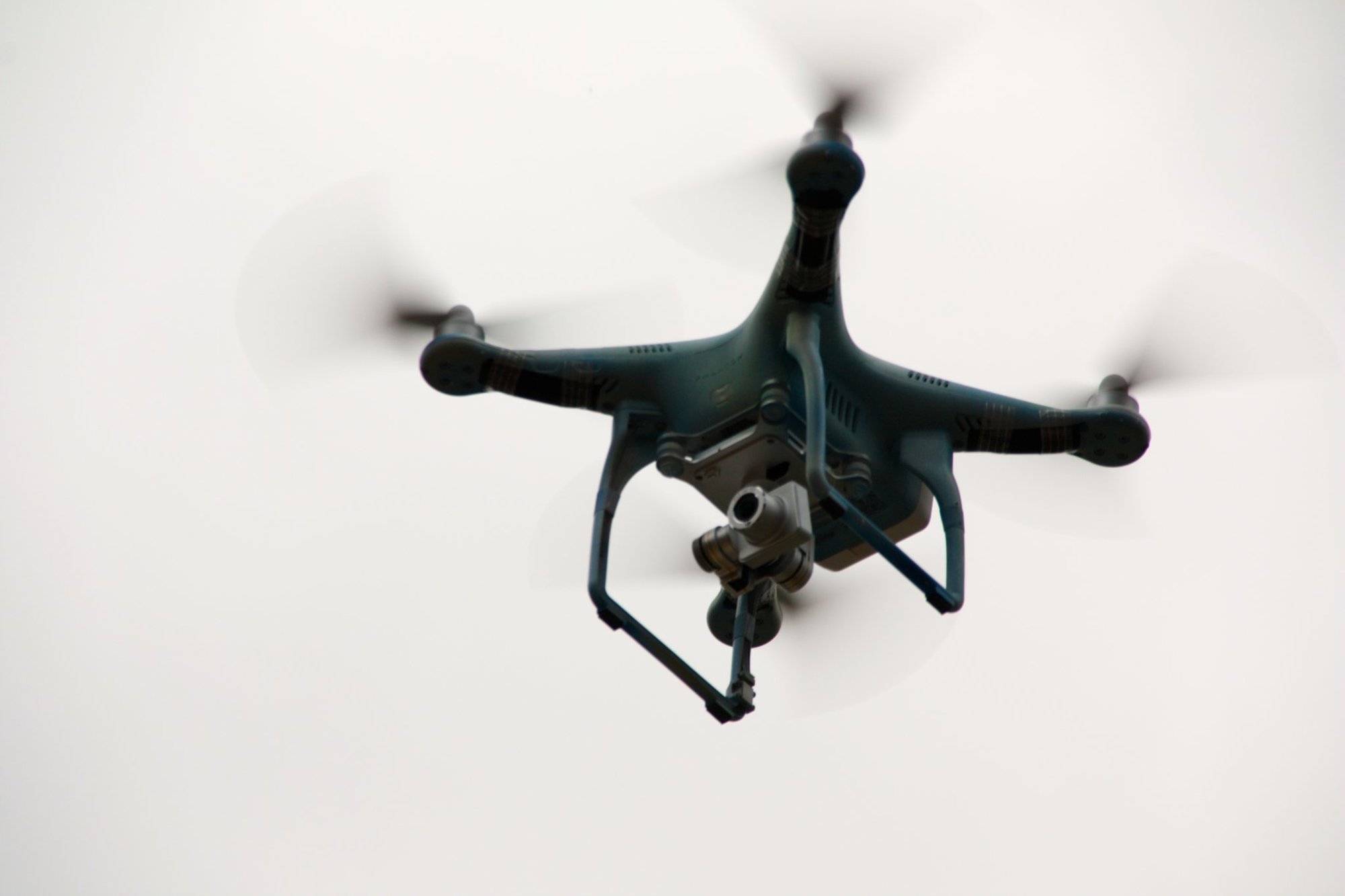
Students at Kyiv’s IT Academy began modifying commercially available DJI Phantom drones for military use in May of 2014. Photo by Nolan Peterson/Coffee or Die Magazine.
MARIUPOL, Ukraine — Widespread aerial warfare debuted in the skies above Europe’s World War I trenches. A century later, another trench war is ongoing on European soil. And while the skies above the eastern Ukrainian battlefields remain innocent of bomber formations or dogfighting fighter jocks, they’ve become a test bed of sorts for air combat’s latest evolution: drone warfare.
Against Russian-led forces on the front lines in Ukraine’s Donbas region, inexpensive drones (often modified, off-the-shelf commercial models) provide Ukrainian troops with man-portable tools that can be rapidly employed in combat to provide real-time intelligence, surveillance, and reconnaissance (ISR) during small-unit raids across no man’s land. During the daily grind of trench warfare, drones have become a key means by which Ukrainian forces target their mortars, artillery, and tank shots. And, in some cases, the Ukrainians have jury-rigged small commercial drones to drop grenades and small antipersonnel munitions on their enemies.
“Nowadays, the use of converted drones by Ukrainian military forces is a valuable tool in daily reconnaissance for infantry units on the front line, making strikes against enemy vehicles and artillery positions, as well as providing intelligence for [special operations forces] and providing constant support during patrolling missions,” Staff Sgt. Kostiantyn Denysiuk, a Ukrainian special operations forces company first sergeant, told Coffee or Die Magazine in an interview.
“My unit used drones mostly for ISR and the general gathering of intelligence. But there were also times when we used them as a means of giving target coordinates to artillery,” said Denys Antipov, a former first lieutenant who commanded a recon drone platoon in the Ukrainian army’s 81st Airborne Brigade from 2015 to 2016.

The Information War
Along a relatively static, roughly 250-mile-long front line in the Donbas region, Ukraine’s military is engaged against a combined force of Russian regulars, pro-Russian separatists, and foreign mercenaries. The war, as it currently exists, is a low-intensity, stalemated conflict, characterized by intermittent, indirect-fire potshots.
The opposing camps are essentially sitting in place, weathering daily artillery and sniper fire without trying to achieve a strategically significant breakthrough. The war’s first cease-fire, signed in September 2014, banned either side from prosecuting an air war. Although the fighting has continued on the ground, the air combat prohibition has largely stuck and air power has not played a significant role in the conflict since the summer of 2014.
The relatively static style of combat has made the war in Ukraine a laboratory for the advancement of drone warfare tactics and technology. Drone operators, who are able to operate from relative safety within trenches and fortified redoubts, feed targeting information to their unit’s indirect fire assets.
Antipov’s unit used the Ukrainian-made “Mara” drones — a military model produced by Ukraine’s national military-industrial conglomerate, Ukroboronprom.
“They were small and unarmed, but they were absolutely cost-effective. So we used them mostly for ISR,” Antipov said of the Mara drones. However, he added that the recon drone platoon he commanded received nearly all their equipment from civilian volunteers.
“Back when my battalion was formed, although I was a UAV platoon leader, my platoon had no vehicles, no trucks, no UAVs,” Antipov said, using the acronym for unmanned aerial vehicles. “Everything we had for one year or so was bought from donations and volunteer support. Except for our weapons and uniforms, of course.”
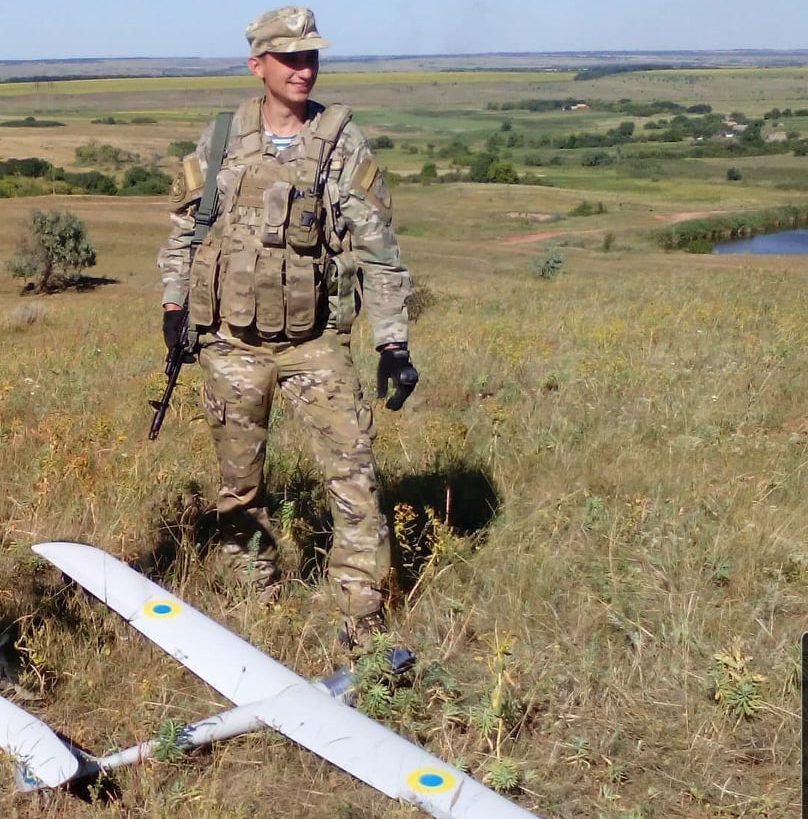
The Mara drones that Antipov’s unit operated became a coveted tool for combat forces. And his unit’s services were soon in high demand.
“The UAVs gave us vital updates,” Antipov said. “Sometimes other battalions and brigades who did not have any drones requested our help for gathering info and aerial footage of the enemy’s defense lines.”
The drones were so important to combat operations that Antipov decided to go on a daring raid across no man’s land to recover another Ukrainian battalion’s drone that had been jammed and forced to land on the Russian side of the front line. Antipov said he used his own unit’s drone for the “search and recovery operation.” Once he’d determined the downed drone’s location, he took two of his soldiers across no man’s land at night and brought it back.
“Information is valuable,” Antipov said. “Especially in war.”
Ukraine’s front-line units are currently training to employ Turkish-made Bayraktar TB2 strike drones. The Bayraktar, which has a maximum altitude of about 27,000 feet and can stay aloft for some 27 hours, is capable of firing a variety of weapons, including antitank missiles. Kyiv announced in January 2019 that it was purchasing an unspecified number of the Turkish combat drones.
Azerbaijan’s military employed the Bayraktar to lethal effect during combat against Armenian forces in the disputed Nagorno-Karabakh region. To date, however, Ukrainian forces have not used the Turkish drone in combat against combined Russian-separatist forces in the eastern Ukrainian war zone.
“Those Bayraktars we’ve got from Turkey are still being tested and have seen no real-life use. I hope that will change for the better. As the recent developments in the Armenia-Azerbaijan conflict show, they are very effective weapons,” Antipov said.
Describing the use of drones among Ukrainian front-line forces today, Antipov added: “Compared to 2016, the situation has improved in terms of technology. But in my opinion, and from what I hear from the guys out there, we still have problems with attack drones. I mean there is not enough.”
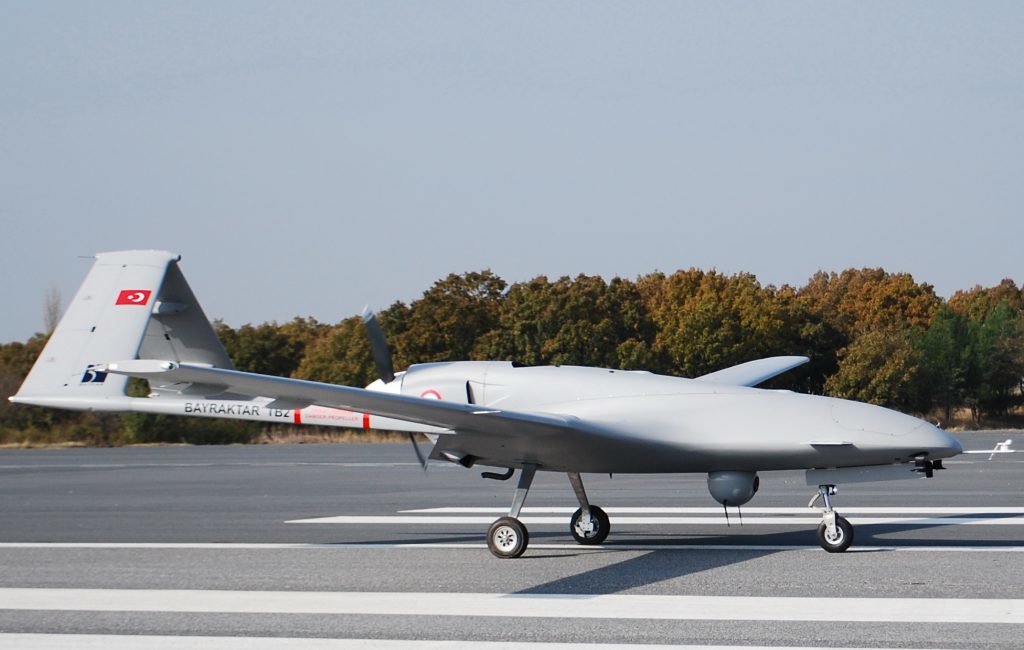
Death from Above
The use of small, converted drones to drop antipersonnel explosives has become a staple tactic for both sides on eastern Ukraine’s entrenched battlefield. In sum, strike drones have become a psychological warfare tool, casting the front lines under the pall of an omnipresent and lethal threat from above.
At the southern end of the Donbas front lines near the city of Mariupol, the Ukrainian National Guard’s Azov Regiment operates the commercially available DJI Mavic 2 drone for both reconnaissance missions and airstrikes.
“We spot targets with our drones and then try to take them out with our artillery,” Anton Kolomoets, a Ukrainian National Guard soldier in the Azov Regiment told Coffee or Die Magazine in an interview.
The DJI Mavic 2 has an advertised flight time of about half an hour and, as a factory option, can come equipped with a special zoom camera. With its battery, the small drone weighs roughly 2.5 pounds and has a “maximum flight distance” of some 11 miles, according to the DJI website. The Azov Regiment now operates five such drones, which have been modified to drop homemade bombs.
Those bombs are made from an empty aluminum energy drink can with one end cut off and filled with explosives. A plastic tail fin, which is made by a 3D printer, is attached to the cutoff end to provide stabilization in free fall. Kolomoets estimated that the Azov Regiment’s drone strikes have killed at least one enemy soldier and wounded some 10 others.
Those bombs are made from an empty aluminum energy drink can with one end cut off and filled with explosives.
Denysiuk, the Ukrainian special operations soldier, said the procedure is “pretty simple” to convert commercial drones into so-called strike drones. First, he said that commercial drones — such as the DJI Phantom and Mavic 2 — can be “reprogrammed” to increase their range and speed.
“Then, we apply the commercial delivery drop system. The final stage is the preparing of charges from 30 mm automatic grenade launcher ammo,” Denysiuk told Coffee or Die Magazine.
“That’s it — a brand-new striker drone is now ready to fight and defend itself,” Denysiuk continued. “Sometimes the drones become KIA by enemy bullets or anti-drone electronic rifles. But, in any case, it’s better than a lost man. Needless to say, our enemy uses absolutely the same tricks.”
The converted Ukrainian drones have nowhere near the range, survivability, or available firepower as advanced American drones such as the MQ-1 Predator. However, Ukrainian forces want to exact pinprick lethal strikes on their enemies without provoking a major escalation. Consequently, the use of such inexpensive airstrike platforms is a perfect match for the Ukrainians’ limited combat objectives in the Donbas.
“The other side does it to us,” Kolomoets said. “It would be great if we could get armed UAVs into every platoon.”
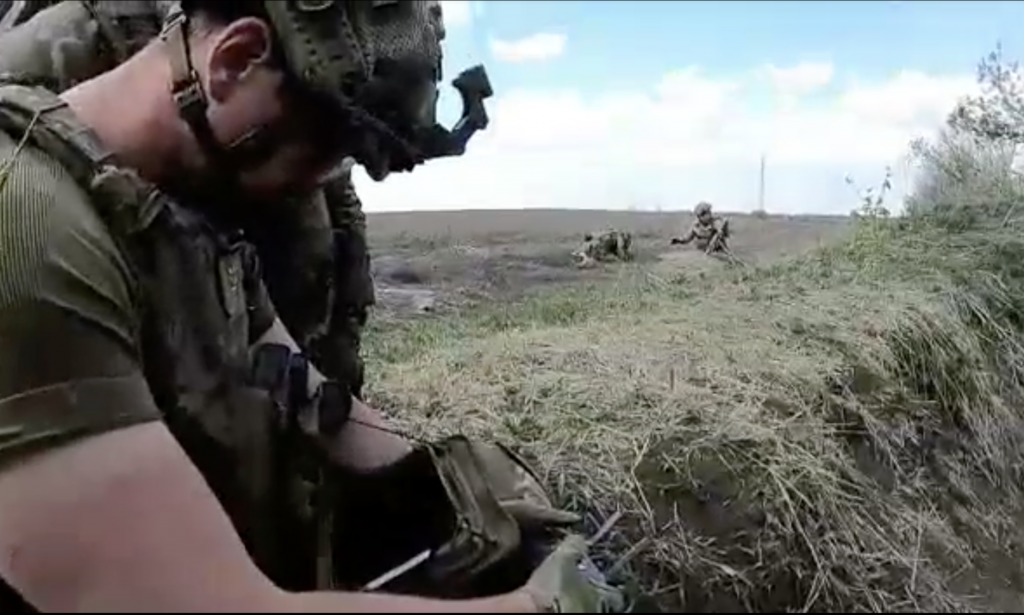
The Russian Side
Russian forces also use drone warfare in their operations in eastern Ukraine — employing drones both for targeting indirect fire and dropping bombs.
According to a December 2016 report on the war in Ukraine by the US Army’s Asymmetric Warfare Group: “Russia does not currently possess a weaponized [unmanned aircraft system] similar to a Predator, however, in Eastern Ukraine there are reports that the [Russian Led Separatist Forces] have weaponized small octo-copters. These non-standard [unmanned aircraft system] platforms have reportedly dropped incendiary and fragmentation grenades on Ukrainian positions.”
On Nov. 19, 2019, a Ukrainian soldier sustained life-threatening shrapnel injuries after a Russian drone dropped a grenade on his unit’s position near the front-line village of Syze. Ukrainian military officials later claimed the drone had launched from within Russian territory.
On May 2, Ukraine’s military said one of its soldiers sustained a shrapnel wound from a VOG-17 fragmentation round that had been dropped from a drone operated by “Russian-occupying forces” over a Ukrainian army position in eastern Ukraine. And on June 11, a grenade dropped from a drone near the front-line village of Pavlopil wounded another Ukrainian soldier.
The Army Asymmetric Warfare Group report said Russia’s preferred drone warfare strike tactic in eastern Ukraine is to send a “wave” of drones to “drop incendiary grenades on front line troop positions.”
“When the Ukrainians come out of their bunkers to put out the fires, a second wave of drones drops fragmentation grenades on the now exposed soldiers,” the report said.

Ukrainian combat units now conceal their front-line positions from Russian drone attacks. On the radio, the Ukrainians refer to enemy drones as “birds.” If the drone is carrying weapons, it’s called a “bird with eggs.”
This correspondent has observed Russian tanks using drones as forward observation platforms to effectively “walk” their guns onto Ukrainian targets.
“In Eastern Ukraine, Russian forces have demonstrated their ability to direct and adjust fires with their drones,” wrote the authors of the Army Asymmetric Warfare Group report on Ukraine.
The Ukrainians have learned, through trial and error, to avoid certain behaviors that might give away their positions to drones — such as smoking cigarettes outside at night. Gone are the habits from the early days of the war when Ukrainian soldiers would haphazardly spray automatic weapons fire at the buzz of Russian drones orbiting overhead in the night. Ukrainian troops now understand that kind of behavior unnecessarily exposes their entrenched positions and invites the inevitable Russian artillery riposte.
Similarly, security measures at military arsenals across Ukraine have been increased following a series of devastating acts of sabotage, which some officials believe were carried out with the use of drones. Ukrainian investigators, for example, believe an enemy drone set off a massive explosion and fire at a munitions depot on an army base near Kharkiv in March 2017.
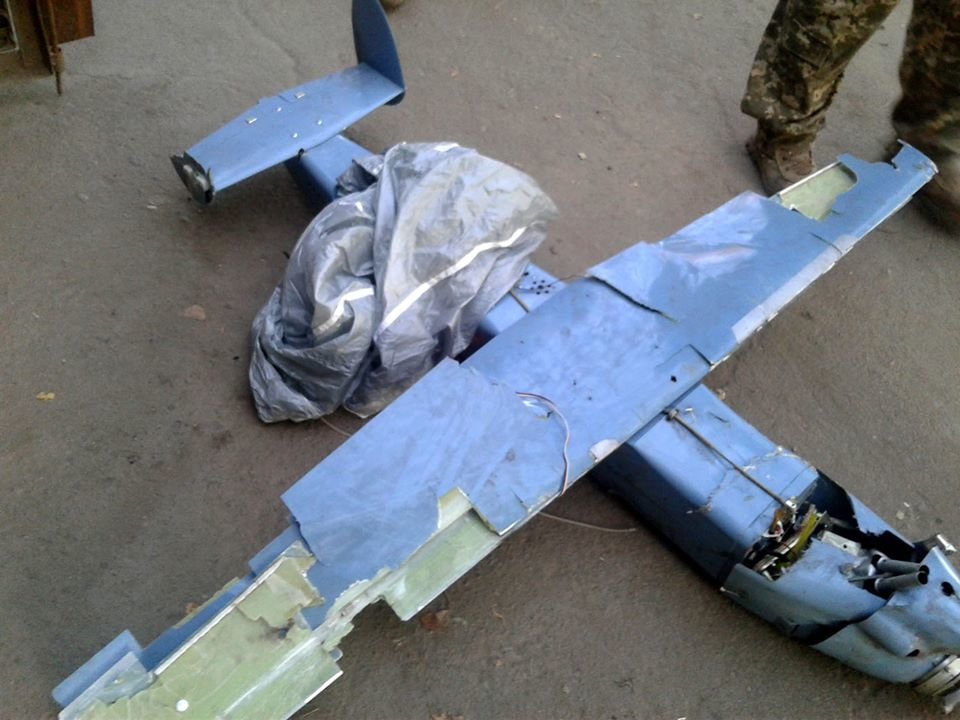
Wake-up Calls
For Ukraine, the situation was dire in the summer of 2014. Russia’s irregular warfare campaign was on the march, taking town after town in the Donbas. There were worries then that Ukraine could be split in two. And the prospect of a large-scale Russian invasion hung like a sword of Damocles over the entire country.
“There was a real chance the front could have collapsed in 2014,” Antipov said. “Nobody knew what was going to happen. So, many young people wanted to train for guerrilla warfare.”
At that time, Ukraine’s regular army had been depleted by decades of corruption and was only able to field a few thousand combat-ready soldiers. Similarly, Ukraine’s meager air force took a beating in the war’s opening months, when the influx of Russian surface-to-air weapons turned eastern Ukraine into one of the world’s most heavily defended airspaces.
In the opening months of the war, combined Russian-separatist forces — armed with Russian surface-to-air missiles and man-portable air defense systems — shot down Ukrainian helicopters, fighter jets, and transport aircraft at a devastating pace. According to Ukrainian military reports, Russia’s forces downed 23 Ukrainian military aircraft prior to the war’s first cease-fire in September 2014. That loss represented about 12% of the country’s fleet of 187 aircraft at the end of 2013.
As the war progressed in the summer of 2014, Ukrainian troops found themselves in a mobile, armored conflict against Russian forces without close air support and with next to no ISR capability. Consequently, Ukrainian forces were plagued by a perpetually incomplete understanding of the battlefield.
“Lack of intelligence always made for a poor planning process. And as a consequence, it became extremely dangerous even for defensive operations,” Denysiuk, the Ukrainian special operations soldier, said of the war’s early months.
“Ukraine went into the war with Russia technically totally unprepared,” Denysiuk told Coffee or Die Magazine. “It was especially striking seeing large, miles-long Ukrainian military supply convoys, which were very often trapped in large-scale ambushes. There was hardly any field reconnaissance, and we had almost no intelligence collection equipment.”

As Russian surface-to-air missiles systematically culled the Ukrainian air force, Ukrainian special operations forces were called upon to infiltrate into enemy territory to recover downed pilots. On those missions, Denysiuk said, the need for dependable ISR became painfully apparent.
“Ukrainian [special operations forces] suffered badly in the search and rescue operations for downed pilots. Because of that, it was the first wake-up call, which motivated us to make changes in the old recon process,” Denysiuk said, explaining what initially spurred Ukrainian forces to integrate small drones into their combat operations.
“The second [wake-up call] happened when the war became a stable trench and minefield scenario,” Denysiuk said. “Both sides established permanent observation positions in the trenches, using night and thermal vision, which made on-foot recon very risky and not too efficient. There was no possibility to safely position our artillery spotters, providing them with good fields of view — though they were critically needed for the sake of targeting our weapons.”
The Professor
Frustrated by Kyiv’s lack of investment in drone warfare, Ivan Dovgal, head of the Kyiv IT Academy’s robotics lab, decided to leverage the skills of his students and colleagues to launch a crowd-sourced drone assembly and training program in May 2014, just one month into the war.
At their university workshop, Dovgal’s team crafted a drone system that could be packed and transported in a container about the size of a briefcase and deployed in the field in about 10 minutes. In a process that took about two days, the DJI Phantom drones were modified to carry Sony A-7 video cameras and to have greater range. Able to reach an altitude of about 5,000 feet and with a horizontal range of more than a mile, the modified drones allowed troops to scout enemy positions without mounting foot patrols that were vulnerable to ambush.
The total cost of each drone and its modifications ran about $2,300 — a real bargain compared against the similarly sized, 4.2-pound US RQ-11 Raven drone, which costs about $35,000. (Each complete Raven system, including control equipment, is estimated at about $250,000, according to GlobalSecurity.org.)
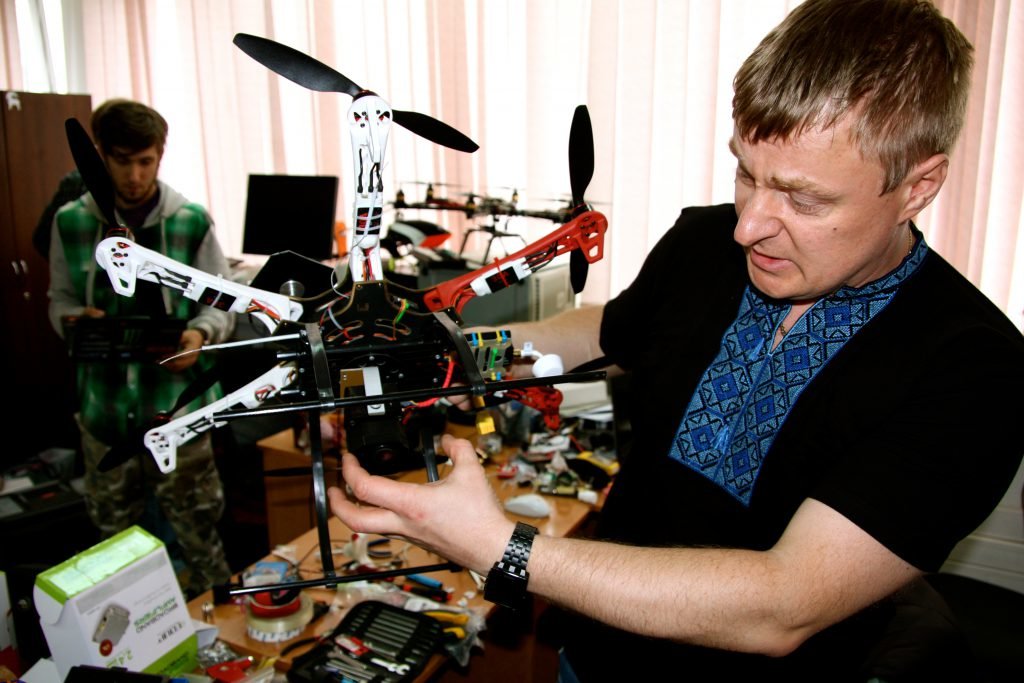
Besides affordability, one of Dovgal’s key goals was to build drones that soldiers could easily fly using an iPad or smartphone after just a few hours of training. For his part, Dovgal often accompanied civilian volunteers to transport the drones to the front lines, where he put Ukrainian troops through a whirlwind pilot training program.
“These drones are very, very easy to use,” Dovgal explained to this correspondent at the time. “Very user friendly. It’s intuitive like an Apple product. You can just turn it on and fly it.”
Dovgal’s grassroots drone conversion program represents one of a number of similar efforts spearheaded by patriotic and technologically savvy Ukrainians who built their country’s ad hoc combat drone program from the ground up in the war’s early days. Small drones like the DJI Phantom and Mavic 2 were ultimately able to accomplish some of the same surveillance and reconnaissance tasks as manned aircraft and helicopters at a fraction of the cost.
“It’s much easier to train a drone pilot than a helicopter pilot,” said Dimitri Franchuk, an engineer at the IT Academy. “And if a drone gets shot down, it’s nothing. If a helicopter is shot down, it’s much worse.”
“With the great portion of Ukrainian volunteers assistance, a lot of [special operations forces] teams and conventional recon units got small civilian drones like the DJI Phantom or Mavic,” said Ukrainian special operations soldier Denysiuk.
“Reinforced by power zoom or thermal vision cameras, they became very effective in combination with artillery precision fire,” Denysiuk continued. “Every day, drone intelligence collection became routine for many hot places on the front lines.”
The Raven
In 2014, the US agreed to supply unarmed RQ-11 Raven drones to Ukraine as part of a broader $75 million assistance package of nonlethal aid. The US gave some 24 Ravens in all to the Ukrainian military. The small drones, which are tossed in the air like a giant paper airplane, were scattered throughout various units, including the Ukrainian army’s 92nd Mechanized Brigade, which operated several Ravens from a front-line position near the embattled town of Marinka in November 2016.
“The Raven is a non-offensive weapon, but we use it for artillery spotting,” Ukrainian soldier Vsevolod Chernetskyi, who was a Raven operator for the 92nd Mechanized Brigade, said at the time.
“It’s useful mostly because it can fly at night,” said Chernetskyi, who trained on the Raven with the US Army for three weeks in Huntsville, Alabama.
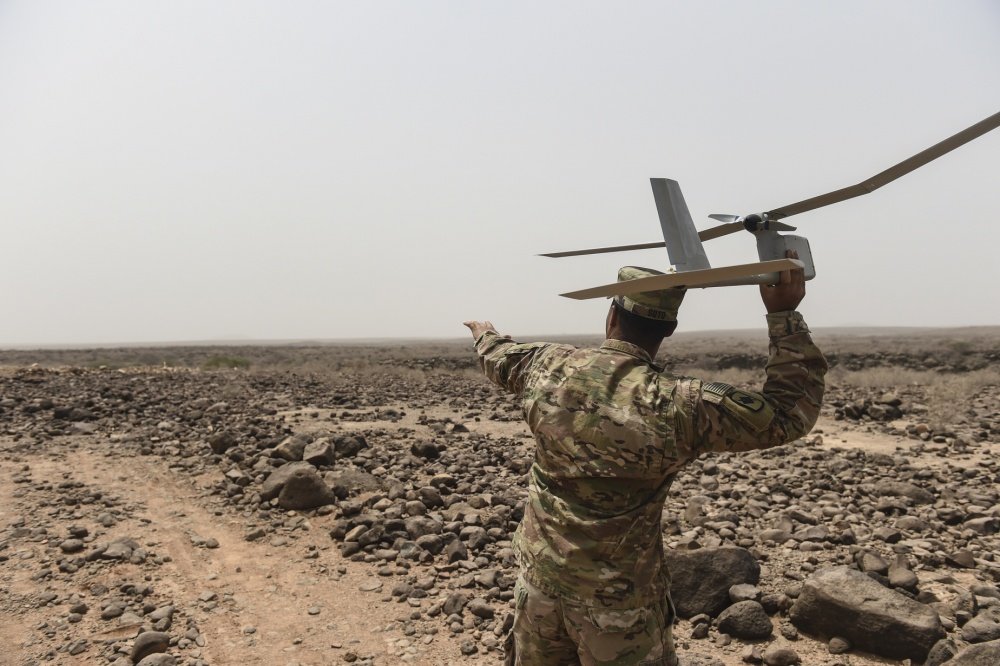
The Raven wasn’t a game changer on the battlefield, but it afforded the Ukrainians some advantages over the modified off-the-shelf drones they also used. Chernetskyi said the Raven’s biggest advantage is its sensor, which is effective at night and instantaneously relays GPS coordinates.
While there have been no confirmed drone air-to-air kills in Ukraine to date, both sides use electromagnetic weapons to jam their adversary’s drone control feeds. As the war in Ukraine transitioned into a static artillery slugfest, the Ukrainians learned the American Ravens — which were designed for counterinsurgency warfare against low-tech enemies — were particularly vulnerable to Russian jamming.
“The Russians can jam it, no problem,” Chernetskyi said of the Raven. “It was made for Afghanistan, and the Taliban didn’t have jamming.”
Surveillance drones used by the Organization for Security and Cooperation in Europe (OSCE) cease-fire monitors have also been routinely brought down by Russian jamming over the years, highlighting how electromagnetic warfare technology has become somewhat akin to the flak batteries used in previous conflicts to defend against aerial attacks.
“The Russian side of the front line was well covered with electronic warfare defenses,” Denysiuk said. “For that reason, using the aircraft type of unmanned aerial vehicles [such as the Raven] was strictly limited and didn’t cover the Ukrainian military’s common intelligence needs.”
Drone War Savvy
The February 2015 Minsk II cease-fire froze the war in Ukraine along its current geographical boundaries and banned weapons with calibers greater than 100 mm from the contact line. But the war never ended.
Wary of heavy casualties, as well as the prospect of spurring a Russian counteroffensive, Ukrainian troops have advanced in fits and starts over the past few years, mostly relying on small-unit raids to take pockets of territory and overrun isolated enemy positions. The two sides have, at places, hunkered down within yards of each other — close enough to shout verbal insults in some cases.

The most recent round of peace talks between Moscow and Kyiv has reduced the intensity of fighting in the Donbas to its lowest level in years. However, a number of Ukrainian veterans and active duty personnel openly oppose the move, claiming that the concessions Kyiv has made to Moscow for the sake of reenergizing peace talks have, in the end, left Ukraine vulnerable to a sneak attack.
For one, the new peace terms reportedly forbid the use of drones on the front lines. Some Ukrainian troops told Coffee or Die Magazine that Russian forces in the Donbas are not obeying that prohibition, leaving the Ukrainians at a dangerous disadvantage.
“According to the new rules of engagement, using any types of drones is totally restricted. That means our company’s reconnaissance-striker converted drone became a retired veteran,” Denysiuk said.
He added: “Such changes have blinded our forward forces. It is a very unsettling feeling — not to know what the enemy is doing at a given time. But in the end it’s the soldier’s job to follow orders, not ask unnecessary questions. Ukrainian fighters are awaiting the outcome of the truce and, just in case, have their own trump cards up their sleeves — for example, small strike drones tested in battle.”
Apart from the grassroots strike drone program, Ukrainian IT students — working on their own initiative — have designed smartphone apps that remotely target mortars, share battlefield maps, and provide encrypted combat communications.
According to the Army Asymmetric Warfare Group report, Ukraine’s armed forces “found the majority of their success through flexibility, creativity, and outside the box solution development bred out of the necessity to survive. The same sense of urgency should permeate our force sooner rather than later. Waiting for new technology to fix our problems with existing enemy capabilities will leave the US ill prepared for the next fight.”
“Ukrainians on the front line didn’t wait for better luck; they made their own rules of war relying on themselves and their military savvy — our fresh mind and savvy is our greatest strength,” Denysiuk said.

BRCC and Bad Moon Print Press team up for an exclusive, limited-edition T-shirt design!
BRCC partners with Team Room Design for an exclusive T-shirt release!
Thirty Seconds Out has partnered with BRCC for an exclusive shirt design invoking the God of Winter.
Lucas O'Hara of Grizzly Forge has teamed up with BRCC for a badass, exclusive Shirt Club T-shirt design featuring his most popular knife and tiomahawk.
Coffee or Die sits down with one of the graphic designers behind Black Rifle Coffee's signature look and vibe.
Biden will award the Medal of Honor to a Vietnam War Army helicopter pilot who risked his life to save a reconnaissance team from almost certain death.
Ever wonder how much Jack Mandaville would f*ck sh*t up if he went back in time? The American Revolution didn't even see him coming.
A nearly 200-year-old West Point time capsule that at first appeared to yield little more than dust contains hidden treasure, the US Military Academy said.












